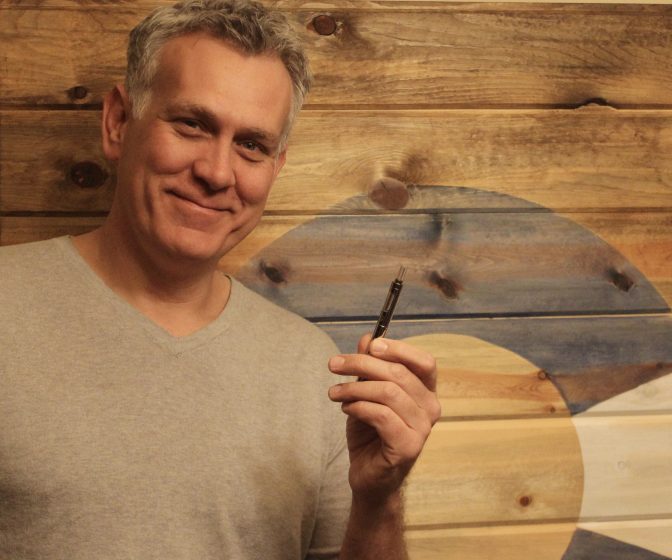The Hidden Truth About Portable Vaporizers

By Chris Goldstein and Jahan Marcu
The hottest trend in cannabis accessories today is the discrete, portable vape pen. The telltale warm glow of a LED light as a consumer takes a puff has become ubiquitous across the country.
Medical dispensaries and retail stores are selling hundreds of thousands of these devices. Some new medical marijuana laws, like in New York, have prohibited smoking altogether and allow vaporization instead. But since vape pens have only been around for about a decade, there’s no research into their long-term health effects.
Pre-filled hash-oil cartridge pens are beginning to dominate the market. Many are cheap, disposable and mass produced, and fail frequently. In Colorado and California, pot shops have closets full of defective pens returned by consumers; they regularly get up to 25% of them back.
Now two emerging companies are looking to change the game with higher quality and reliability. Todd Mitchum of ION Vape in Denver has made it his mission to build a better low-cost pen.
“I got into this after literally witnessing bad tech,” he tells Freedom Leaf. Mitchum runs down the list of the most common problems: “Exploding batteries, low-grade plastic cartridges and glue that’s used to hold the atomizers and pieces in place.”
Mitchum should know about vaporizers and cannabis oil. He worked at O.PenVape in Denver as Chief Revenue Officer until he left to start his own businesses in 2014. He’s since founded the dating service High There, and now ION Vape.
“I saw the shortcuts manufacturers use in products,” he explains. “Listening to consumers and lawmakers, they were all concerned about safety. We started asking lots of hardware experts how to build a cleaner, safer, better product.”
It took some time, but now ION Vape is confident they have a winning formula: a recyclable cartridge made from medical-grade glass you’d find in a laboratory. “It keeps all the contaminants out without degrading,” Mitchum says. “If you have plastic in your cartridge, it could be out-gassing plastic into your body.”
He contends that many companies are putting top notch-oils into bad cartridges: “It would be horrible to find out one day that all the good we’ve done with cannabis can be undone by bad hardware.”
In California, Bloom Farms manufactures a vape pen named the Highlighter. Unlike Ion Vape, Bloom Farms makes their own oil, using supercritical carbon dioxide, not butane or other solvents. All of the extraction and filling of the cartridges is done in a clean facility that mirrors a chemistry lab.
“We’re here to bring a healthy perspective to life with cannabis,” proclaims the company’s mission statement. Not only are their pens recyclable, the packaging is responsibly sourced. Bloom Farms product are currently available at 25 dispensaries and delivery services in California.
Hot Stuff: The Battery Breakdown
The lithium-ion batteries used in many compact electronic devices, such as cellphones, have the ability to store large amounts of energy in a small space. They’re also sometimes described as a “mini-bomb in your pocket” due to their known ability to ignite; photos of charred cellphones litter the Internet.
Lithium batteries got the attention of the nation when the gift fad of this past holiday season, hoverboards, were shown to catch fire with alarming regularity. Many of these battery fires were shown on TV news reports.
In 2014, the U.S. Fire Administration published a report that identified at least 25 incidents involving fires caused by e-cigs. The majority occurred while charging the devices. It should be noted that none of these cases involved a pen used for cannabis.
And in 2015, an article in The American Journal of Medical Case Reports documented a lithium battery-powered e-cigarette going fully thermal in a man’s pants pocket: “While attending a rock music concert, the man reported hearing a sudden loud noise described as an ‘explosion,’ which caused his entire right pants leg to rapidly ignite in flames.” The victim suffered burns over 8% of his body.
A number of factors can cause a lithium battery-powered device to enter a condition known as “thermal runaway.” That’s where the battery temperature increases to the point of combustion. Poor design, use of low-quality materials, manufacturing flaws and defects and improper handling all contribute to the risk of a fiery malfunction. Batteries are also the main reason for failure in many disposable pens and e-cigs.
“A battery is inherently a device that, if not treated properly, can do damage,” cautions Mitchum. “They don’t get wired properly, or cases get damaged, or people use a different charger. Batteries that fail and leak can explode or overheat.”
ION Vape and Bloom Farms purchase batteries manufactured in China. Both companies have found ways to reduce battery failure to a fraction of that of other products. Bloom Farms performs their own quality testing on batteries, and claims to have less than 1% returns.
The key is to have better management of the battery production process. “We have a team in China on the ground that oversees this,” Mitchum offers. “Each one is tested and inspected as they are assembled.”
Oil Additives and Flavoring Agents
There are also safety concerns about the cannabis oils used to fill cartridges. Like nicotine e-juices, many cannabis oils include additives, such as vegetable glycerin and propylene glycol. These liquids dilute the oil and make it flow better, but when heated at high temperatures, they can produce toxins.
Bloom Farms uses polyethylene glycol 400, known in the industry as PEG or PEG-400. Commonly found in creams, shampoos, eye drops, vitamins and suppositories, PEG-400 is a pharmaceutical-grade product that can create formaldehyde at smoldering temperatures. About 10% of the oil in the Bloom Farms cartridges for their Highlighter pens consists of PEG-400. While oils produced by Bloom Farms are fortified with some extracted cannabis terpenes, no other flavors are added.
Also of note is that the Highlighter, because it’s under 4 volts, doesn’t get hot enough to burn the PEG-400, so it’s not creating formaldehyde. The details are in a white paper from Bloom Farms and can be accessed, here.
It’s the fruity flavorings often found in oil cartridges that consumers should be especially beware of. An irreversible respiratory disorder known as “popcorn lung” made some headlines a few years ago; it’s primarily characterized as bronchiolitis obliterans, which can occur from chronic inhalation of certain flavoring compounds. Butter flavoring containing diacetyl was identified as the cause of an outbreak of lung disease in workers at a food plant in 2000. Litigation documents suggest the outbreak was related to diacetyl-containing formulations.
Those cases created a call for more criminal penalties against companies and even executives who knowingly hide information relevant to worker and consumer protection. It also showcased the need for systemic changes in food-product regulation and for corporations to act responsibly. This effort may now need to extend into the world of cannabis product manufacturing.
Both diacetyl and acetylpropionyl—two chemicals approved as flavoring additives, found in 72% of nicotine e-cig products—are now associated with respiratory disease. The same chemicals can be found in some flavored cannabis oil cartridges, but manufacturers seldom fully list ingredients and are not inclined to reveal what’s in their cartridges.
Dilution liquids and flavorings don’t have to be used at all, according to Mitchum, who says the ION Vape works perfectly fine with pure hash oil: “The atomizer is wrapped in titanium, so you don’t need to put in polyethylene in order to vape. It’s designed to use oils that aren’t cut at all.”
Is the Pen Mightier Than the Pipe?
How beneficial is vaping for respiratory health compared to smoking cannabis? America’s leading cannabis and lung expert, Donald Tashkin (see “The Pulmonary Soothsayer” in Issue 10), thinks the benefits of switching from smoking flowers to vaping hash oils are relatively minor compared to those of transitioning from tobacco smoking to nicotine vaping.
Cannabis smoking is associated with some chronic respiratory symptoms (coughing, wheezing, sore throat, phlegm), but not with shortness of breath or the disabling symptoms of chronic obstructive pulmonary disease (COPD), which are commonly connected to tobacco use.
The weight of epidemiological evidence on old-fashioned joints and pipes doesn’t show significant airflow obstruction and “argues against cannabis as a risk factor for respiratory cancer,” Tashkin has stated.
Cannabis vaporization is preferential for individuals already suffering from respiratory illness, such as asthma. For this population, smoking could worsen their respiratory symptoms or preexisting pulmonary disease.
However, vaping cannabis is now considered to be safer than smoking.
Vape pens are perceived as less deviant and more normalized than joints and pipes, facilitating the use of cannabis among people who generally would shy away from smoking.
It’s important to note that cartridge pens don’t vaporize oils in the same way a Volcano vaporizes whole-plant cannabis. Portable pens work by “heating the oil to a temperature that is adequate to release the cannabinoids into the air,” says Mitchum. “It vaporizes like water would under extreme heat. Different-viscosity oils vaporize at different temperatures.”
The famous Volcano, which revolutionized the nascent vaporizer industry with its ease of use and turkey-bag functionality, heats dried cannabis flowers to a point where cannabinoids are released, but the plant material itself does not reach combustion.
“With smoking, you can burn off 40% to 60%,” Mitchum points out. “But vaping is much more efficient. In general, with the right hardware, it can be 40% cheaper than smoking.”
Vape pens and e-cigs have gone largely unregulated. If federal cannabis policy changes, and marijuana is eventually re-scheduled under the CARERs Act or de-scheduled under Senator Bernie Sanders’ bill (see “Bernie Sanders Wants to De-Schedule Marijuana” in Issue 12), it would open possibilities to improve product safety.
“With the right tech and the right oils, it’s the way of the future,” Mitchum predicts. “Vaping is going to be one of the things that really pushes cannabis into the mainstream.”
For more info go to ionvape.com and getbloomfarms.com
Chris Goldstein is Senior Editor of Freedom Leaf. Dr. Jahan Marcu is Freedom Leaf’s Science Editor and Director of R&D for Green Standard Diagnostics.

